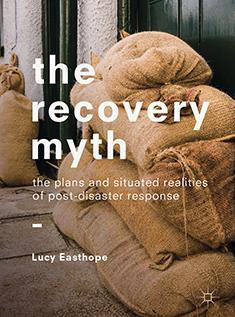 Author
Author
Lucy Easthope
Reviewed by
Associate Professor David King
James Cook University
Published by
Palgrave Macmillan
ISBN: 978-3-319-74555-8
My first reaction to Lucy Easthope’s book The Recovery Myth was: what could we, in a ‘land of flooding rains’, possibly learn from one small flooded village in England? We have far more experience of floods here in Australia than emergency managers and communities do in the UK. However, as I got into what turned out to be a fascinating read, I was swept along by the sheer detail and humanity of a long-term study of a small community’s experience of flood recovery.
I wish I could have had the time and patience to do such research in any of the communities that we have visited after disaster. There is a common experience to recovery from disaster that resonates with our communities here in Australia. Easthope was a professional emergency manager whose social research followed the experience of residents, emergency managers and local government officials for over 5 years.
On 25 June 2007, the village of Toll Bar in Yorkshire was among a number of areas that were severely flooded following exceptionally heavy (for the UK) rainfall that inundated low-lying areas and caused rivers to burst their banks. Floodwaters only receded after 2 weeks so most of the more than 1,000 residents had to be evacuated. Over half of the houses in the village were damaged including many that were local council properties. Many people were housed temporarily in a caravan park. Some remained there for over a year before being rehoused within the village or returned home. The community is a low social economic village that had been perceived by outsiders as a ‘rough place’. Before the flood the village had high unemployment and youth delinquency. These rates decreased after the flood, especially a reduction in the crime rate. The community held together with considerable resilience, but people did not return to a normal or pre-flood state. The recovery process was hard and challenged many emergency management practices and assumptions, but ultimately the people of the community took over their own recovery.
Although Easthope carried out ethnographic research, she came to the community as an experienced emergency manager and questioned many of the ideas of emergency management. She recognises the necessity for emergency managers to bring order but suggests that they come with a pre-conceived framework that, especially in Toll Bar, began with a ‘them and us’ between officials and those affected. I would reflect that this division is more entrenched in English society than it is in Australia where people tend to have a positive attitude towards State Emergency Services and recovery workers. The voices of the people were initially disregarded by officials, but as those affected moved from shock and trauma, they took back control of their lives. As time passed, the attitudes of both sides softened. All the same, response and recovery frameworks are artificial structures. This led Easthope to refer to the official story and lessons learnt reports as fantasy documents. There was a tendency for government officials to think and talk regionally and rationally, while locals talked locally and emotionally. Despite labelling all emergency management planning texts as fantasy documents, Easthope does acknowledge that despite their flaws, recovery plans are designed to focus responders so that they can help the community.
A whole chapter of the book is concerned with the trauma that people felt as their damaged household belongings were dumped as waste. People saw part of their lives and values being disposed of too hurriedly. Out of this came an exhibition that remembered loss and acknowledged community strength and recovery. The community had avoided displacement to other places and had to work together to rebuild their village, as active participants rather than passive recipients. She also draws attention to gender issues as recognition of the different roles and voices of men and women and youth. The recovery community is not homogenous.
Especially interesting is her idea that social capital emerges from the community. We make assumptions about tapping into social capital in order to build resilience. Easthope observes that social capital might not be strong or evident, but it is the disaster that creates social capital. Responders and emergency
managers played a role in bringing out that social capital to facilitate community-led recovery.
Finally, there is a strong theme in this study that community recovery does not reach an end point. Government services may withdraw, but the community lives with the hazard as both memory and future threat. It will come again and their experience of this disaster will shape their recovery next time. This is the reality for most Australian communities. Hazard awareness and future recovery from disaster are interlinked as we live with natural hazards and the threat of disaster.


